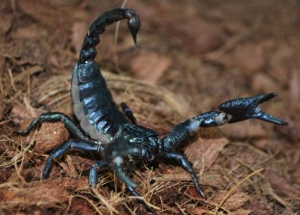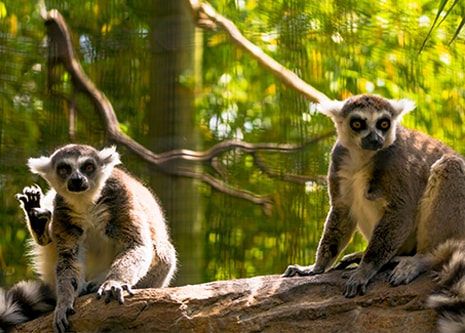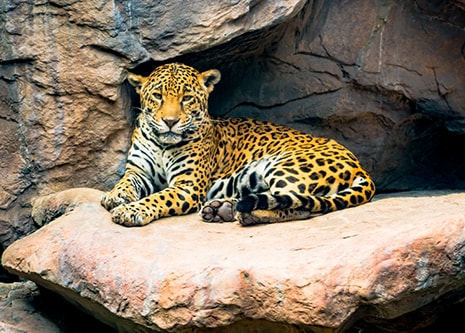
- VisitSupport Happy HollowDONATE TODAYExploreSupport Happy HollowDONATE TODAYLearnSupport Happy HollowDONATE TODAYSupport
-
Today's Hours: 10:00 am to 4:00 pm
Education AmbassadorsGiant Forest Scorpion

Scientific name: Heterometrus spinifer
Family: Scorpionidae
Order: Scorpiones
Class: Arachnida
Range: Southeast Asia
Habitat: Tropical Forest
Lifespan: 7 to 8 years in captivity, less in the wildWhat do they look like?
There are over 33 different species of scorpion that belong to the genus Heterometrus. These scorpions are commonly referred to as giant forest scorpions and share similar characteristics. Giant forest scorpions are one of the larger scorpion species averaging between four to five inches in length. They are arachnids (belonging to the same family as spiders) which means they have two main body parts and eight legs. Giant forest scorpions also have enlarged food-handling pincers, and a segmented tail with venomous stinger at the end of it. Their exoskeleton is black and glows bright teal under ultraviolet light! They have poor eyesight but an excellent sense of touch via hairs found all over their body which detect vibrations through the ground or in the air.How do they behave?
Giant forest scorpions are nocturnal (active and hunting during the night). They are solitary (living alone), and they generally only come together to mate. Giant forest scorpions spend the majority of their time in underground burrows that they dig with their first two pairs of legs. When threatened, the scorpion will face the threat with open claws and arched tail. If further harassed, the scorpion is likely to pinch first and use its stinger only as a last resort.What do they eat?
Giant forest scorpions hunt insects and other invertebrates. At Happy Hollow, they eat a variety of small invertebrates like crickets.How are they born?
Giant forest scorpions engage in a mating dance in which the male grasps the female’s pincers while moving around. The male will decide on a location in which to deposit his sperm sac, and then guide the female to the same location. The eggs are fertilized internally, and females will give birth to live young rather than laying eggs. Gestation is highly variable depending on ambient temperature, food availability, and stress factors. After birth, the young scorplings will climb onto their mother, where they will be carried until they have depleted their embryonic yolk sacs. Once the young scorpions have gone through their first molt (shedding of the old exoskeleton, replacing it with a new one), they will leave their mother and start their life on their own.What should you know about them?
Scorpions have an inverse relationship between venom potency and pincher size. Scorpions with potent venom have smaller pincers while scorpions with less toxic venom have larger pincers to compensate.Conservation
The giant forest scorpion’s conservation status is currently listed as Not Evaluated by the International Union for Conservation of Nature . While giant forest scorpions are not listed as an endangered species at this time, they are still at risk because of the illegal pet trade. Due to their relatively docile nature, this species is the most common scorpion kept as a pet. However, over-collection of wild specimens can substantially affect their populations. You can help giant forest scorpions by leaving them in the wild, rather than keeping them as pets. If you are looking for a new pet, check out your local humane society, where you will find people who can help you make the proper pet choice!
Zoo on the Hill
Located across from the Keep-Around Carousel is the Zoo on the Hill. Learn about wildlife up close during daily meet-and-greets, leap like a lemur on the playground, brush and feed the goats,, or take a peek inside Doc’s Critter Care building and the Ranch House. Double-H Ranch features a combination of animal exhibits, including giant anteaters and red ruffed lemurs, as well chickens and domesticated animals that are docile enough to touch.

Zoo in the Hollow
Follow the crooked bamboo pathway down into the hollow and visit with some of the most amazing animals in the world. Where else in San José can you get up close to a stunning jaguar, lemur, meerkat or American alligator? Happy Hollow is dedicated to helping save species and preserve wildlife for future generations by participating in Species Survival Plan programs through the Association of Zoos and Aquariums.